Part 1: Three-Year Fiscal Plan
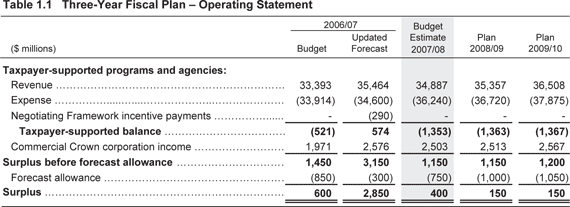
Introduction
Budget 2007 continues government's legislated commitment to balanced provincial budgets. The budget includes additional revenues available
since Budget 2006 as a result of stronger economic performance.
As shown in Table 1.2, Budget 2007 provides for:
- More than $2.0 billion over four years to help British Columbians meet the housing challenges of a growing economy.
- Additional funding for healthcare and K–12 education totaling $1.4 billion over three years, excluding funding for settlement
costs under the negotiating framework. Including funding for negotiating framework costs results in total funding increases
of $3.3 billion.
- Enhanced social services: $468 million over four years for programs and services to support the quality of life for children,
adults and families living in British Columbia communities.
- Justice and Public Safety: $178 million over four years for policing, justice and the corrections system to protect communities
and citizens.
- Strengthening Communities: $189 million over four years for local infrastructure and transportation projects.
- Economic and Resource Development: $315 million over four years to enhance post-secondary educational and training opportunities
throughout the province, reconciliation of Aboriginal rights and title, and additional investments in the natural resource
sectors.
- Environmental Leadership: $103 million for initiatives that protect the environment and support sustainable environmental
management, including $13 million of tax initiatives that support government's environmental objectives.
- Additional tax reductions of $303 million over four years (including implementation of tax reductions included in the 2007 Budget Consultation Paper) for other tax reductions outlined in Part 2: Tax Measures; and
- The surplus and forecast allowance, to help protect the balanced budget plan.
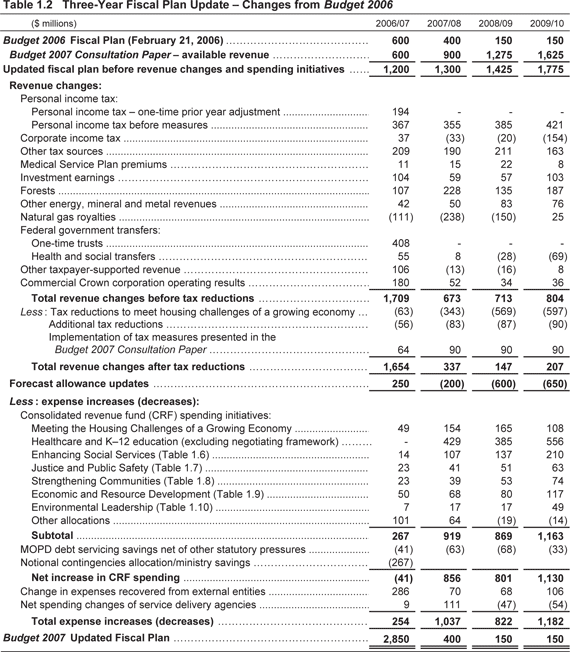
Budget 2007 continues government's commitment to an infrastructure spending plan that is affordable. Provincial capital spending funds
assets that are important to the province and its citizens, including schools, hospitals, medical equipment, university lecture
halls, residences, government buildings, court houses, roads, bridges, dams and transmission lines.
Total infrastructure spending on roads, schools, hospitals, post-secondary facilities and other capital assets totals $5.2 billion in 2007/08, $4.9 billion in 2008/09 and $4.6 billion in 2009/10. The capital plan includes a contingency to cover
risks from higher than expected cost inflation on projects, including the Vancouver Convention Centre Expansion Project, and
includes a preliminary allocation for priority hospital projects in Victoria, Kelowna, Vernon and Fort St. John. More information
on the three-year capital spending plan is found on page 47.
The higher than expected surpluses over the past few years have allowed the province to make significant investments in infrastructure
without adding to provincial debt. For example, the $3.06 billion surplus in 2005/06 and the $2.85 billion surplus in 2006/07
helped finance the following projects:
- $1.61 billion spending on post-secondary facilities including the University of Victoria's Engineering and Computer Science
Building, and the North Cariboo Community Campus in Quesnel;
- $0.65 billion in spending in the K–12 school system including Pacific Heights Elementary school in Surrey, and L'Ecole Victor
Brodeur in Esquimalt;
- $1.70 billion for health facilities and equipment including cancer treatment vaults at the BC Cancer Agency's Vancouver Centre,
and the Mental Health Building for Children at BC Children's and Women's Hospitals; and
- $1.60 billion for roads and bridges including the Cariboo connector program, Kicking Horse Canyon Phase I, and the Yoho bridge.
However, with smaller surpluses forecast from 2007/08 through 2009/10, debt-financing is required to fund the provincial capital
spending program.
Taxpayer-supported debt is forecast to increase by an average 3.2 per cent annually over the next three years to $29.2 billion
by 2009/10, reflecting planned infrastructure spending in the health, education and transportation sectors, offset by expected
operating surpluses. Total provincial debt, which includes commercial Crown debt and borrowing forecast allowances, is forecast
to increase by an average 5.2 per cent annually over the next three years to $40.0 billion by 2009/10.
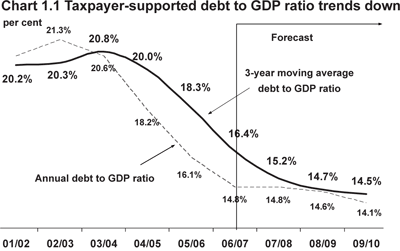
To ensure the debt remains affordable for future generations of British Columbians, the government remains committed to a
declining trend in the taxpayer-supported debt to GDP ratio. Consistent with this commitment the taxpayer-supported debt to
GDP ratio is expected to fall from 14.8 per cent in 2006/07 to 14.1 per cent by 2009/10.
Government's approach to debt management was recognized in 2006/07 when Moody's Investors Service upgraded BC's credit rating
to Aaa, the highest possible rating. In making its decision Moody's cited a well structured fiscal plan, leading to a reduced
debt burden and the expectation of further improvements in the province's debt ratio over the medium term. Additional information
on the debt outlook is found starting on page 53.
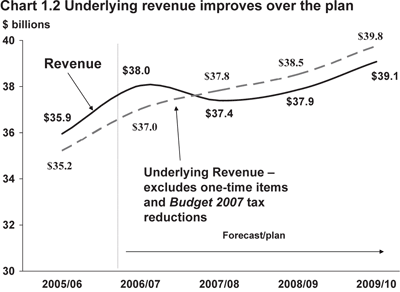
Significant one-time revenues totaling $1.1 billion in 2006/07 do not continue through the full three-years of the fiscal plan.
These include the impacts of prior years tax results ($385 million), equalization revenues (net of reductions in federal health
and social transfers) which end in 2006/07 ($350 million) and one-time federal trust funds ($408 million).
Overall underlying revenues (excluding the impact of one-time items in 2006/07 and before Budget 2007 tax reductions) are forecast to increase from $37.0 billion to $39.8 billion by 2009/10, an increase of 7.5 per cent. These
increased revenues have provided the basis for expanded service levels and lower taxes.
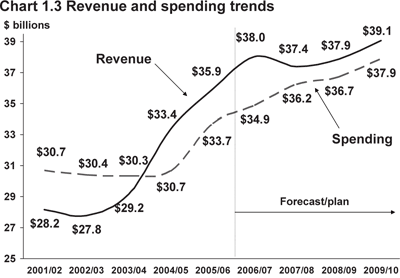
The government revenue forecast is based on income growth, changes in demand for goods and services, commodity prices, the
exchange rate and other related assumptions included in the economic forecast. Revenue also includes forecasts submitted by
Crown corporations and organizations in the SUCH sector.
In addition to the $3.8 billion available revenues identified in the Budget 2007 Consultation Paper, revenues are forecast to have increased over the next three years by a further $2.2 billion, reflecting stronger overall
economic activity, higher forest revenues, and improved investment earnings partially offset by lower natural gas royalties
in 2006/07 through 2008/09. After deducting the impact of tax reduction measures — revenues are up $1.7 billion in 2006/07, $337 million in 2007/08, $147 million in 2008/09 and $207 million in 2009/10 since the Budget 2007 Consultation Paper (as shown in Table 1.2). Budget 2007 reflects tax reductions totaling $1.8 billion (including implementation of tax reductions included in the Budget 2007 Consultation Paper of $270 million), spending commitments totaling $3.0 billion and increased forecast allowances of $1.45 billion, in part
to address the interim nature of the health funding allocations in 2008/09 and 2009/10. The tax policy changes are detailed
in Part 2: Tax Measures.
The fiscal plan is based on the Ministry of Finance's economic forecast that projects economic growth of 3.1 per cent for 2007,
3.0 per cent in 2008 and 3.1 per cent in 2009. Consistent with its prudent forecasting practices, the Ministry of Finance
outlook is lower than the Economic Forecast Council average. Full details of the economic forecast are found in Part 3: British
Columbia Economic Review and Outlook.
Overall spending is forecast to increase by an average 2.8 per cent annually over the next three years to total $37.9 billion
by 2009/10, as funding is increased in most ministry budgets. Individual ministry budgets now reflect the effect of public
sector compensation increases for contracts that have been settled. Amounts for contracts yet to be concluded continue to
be held centrally in a contingencies sub-vote.
The main risks to the government fiscal plan include economic fluctuations such as exchange rate movements or sudden natural
gas or other commodity price changes, and potential changes to federal transfer allocations on the revenue side, as well as
service demand pressures on the expenditure side. These and other risks are more fully described starting on page 56.
A $300 million forecast allowance is retained in 2006/07 to protect the bottom line against unanticipated revenue shortfalls
or spending pressures that may arise before the end of the fiscal year. The fiscal plan also includes forecast allowances
of $750 million in 2007/08, $1.0 billion in 2008/09 and $1.05 billion in 2009/10 to protect the fiscal plan from the revenue
and spending risks such as those cited above.
The higher forecast allowances in 2008/09 and 2009/10 recognize the interim nature of the health spending plans, which have
only been established for 2007/08. The health authority funding lifts for 2008/09 and 2009/10 include funding to cover negotiating
framework costs. The Ministry of Health will continue to work with the health authorities on their financial plans in the
context of the Conversation on Health. The Ministry of Finance will continue to monitor and review these financial plans as
part of budget processes.

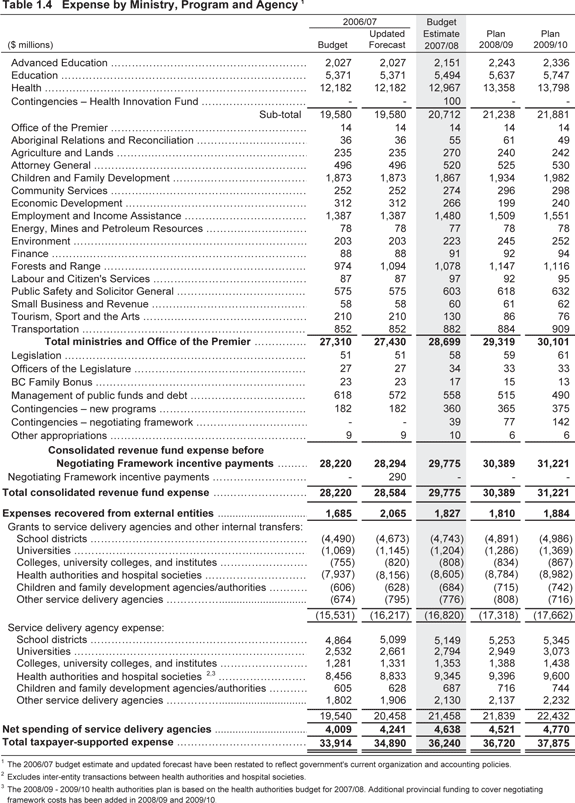
The three-year fiscal plan conforms to the standards set by the accounting profession for senior governments in Canada referred
to as generally accepted accounting principles or GAAP.
Consolidated Revenue Fund Spending
Consolidated Revenue Fund (CRF) spending is forecast to increase from $28.2 billion in 2006/07 to $31.2 billion by 2009/10 — a 10.6 per cent increase.
This budget builds on Budget 2005 and Budget 2006 commitments to seniors and children respectively, and is focused on meeting the housing challenges of a growing economy.
Budget 2007 also provides ongoing funding for investments in natural resources and economic development, protecting the environment and
communities, sustaining and enhancing social services, providing additional skills development and training opportunities,
while continuing government's commitments to health care and education.
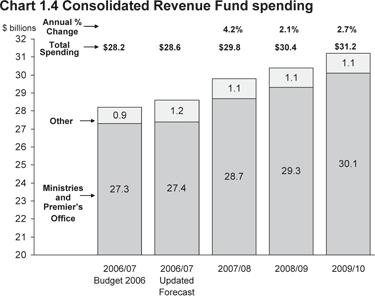
Housing
In Budget 2007, over $2.0 billion is targeted towards meeting the housing challenges of a growing economy. The initiatives in the fiscal
plan are listed in Table 1.5. See the topic box on the next page for a complete discussion of these initiatives.
Health Care
Budget 2007 reconfirms government's commitment to health care and provides $2.69 billion over three years in increased funding beginning
in 2007/08. This is in addition to $987 million previously allocated, for a total funding increase of $3.68 billion. This
increase includes funding for negotiated settlements of $224 million in 2007/08, $440 million in 2008/09 and $723 million
in 2009/10.
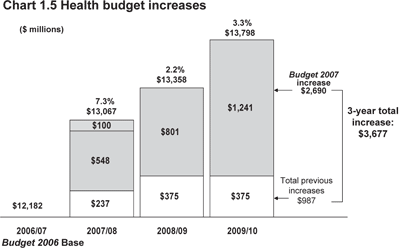
In 2007/08, funding provided for the Ministry of Health and health authorities increases by $885 million, a 7.3 per cent increase
over 2006/07. This includes $100 million for the Health Innovation Fund to promote innovation within the health care system.
The fund will assist health authorities in implementing best practices, restructuring service delivery systems and eliminating
key information bottlenecks.
Health spending by function includes all healthcare related spending by the Ministry of Health, health authorities, other
ministries including Children and Family Development and Employment and Income Assistance as well as other service delivery
agencies such as Canadian Blood Services. Health spending by function will increase to $14.21 billion in 2007/08, up from $9.36 billion in 2000/01, a 51.8 per cent increase.
Health authority funding is increased to $7.53 billion in 2007/08 from $7.06 billion in 2006/07, a 6.7 per cent increase.
For planning purposes, health authority funding increases for 2008/09 and 2009/10 include negotiating framework costs only.
The Ministry of Health will continue to work with the health authorities on their financial plans in the context of the Conversation
on Health. The Ministry of Finance will continue to monitor and review these financial plans as part of budget processes.
To ensure that the Province's three-year fiscal plan remains balanced, the forecast allowances for 2008/09 and 2009/10 recognize
the interim nature of the health spending targets and can accommodate some additional growth in health authority funding.
Additional funding provided in 2007/08 will fund initiatives to improve health services provided to the public, including
working towards providing timely access to key surgical and medical services. For example, funding for life support programs
will increase by $41 million in 2007/08 and provide additional procedures and services, including:
- 185 open-heart surgical procedures;
- 220 implantable defibrillator procedures;
- 900 angioplasty procedures;
- increased usage of drug-eluting stents (i.e. stents coated with medicine to prevent a coronary artery from narrowing again
after angioplasty); and
- cancer drug treatments, renal dialysis treatment and transplant drugs.
In 2007/08, the ministry will continue to engage British Columbians in a discussion on health service priorities through the
Conversation on Health. This will help inform fiscal and service planning later in the fiscal planning period.
Education
Budget 2007 provides $633 million over three years in increased funding for K–12 education. This is in addition to the $132 million allocated
in previous budgets, for a total funding increase of $765 million over three years. This increase includes funding for negotiated
settlements of $94 million in 2007/08, $188 million in 2008/09 and $284 million in 2009/10.
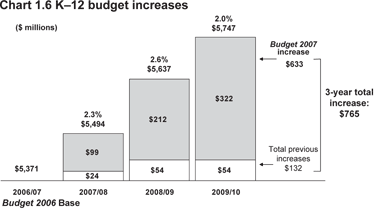
Overall, the K–12 budget increases an average 2.3 per cent per year, and fully funds the negotiated settlements reached earlier
this year with employees in the K–12 sector, as well as an increase to the Teacher's Pension Plan contribution rate.
The negotiated settlements in the education sector balance the interests of taxpayers and employees and allow parents, educators,
students and administrators to build the best possible education system. In addition, the teacher's compensation agreement,
the first to be successfully negotiated since 1994, contains a number of initiatives, including enabling rural and remote
school districts to attract teachers to more difficult to fill positions.
The average per pupil funding for 2007/08 is estimated at $7,910, an increase of 4.1 per cent over 2006/07. Per pupil funding
is projected to continue to rise to $8,430 by 2009/10. There were about 12,300 fewer students in 2006/07 than the previous
year and enrolment is projected to continue to fall about 1 per cent per year over the fiscal plan.
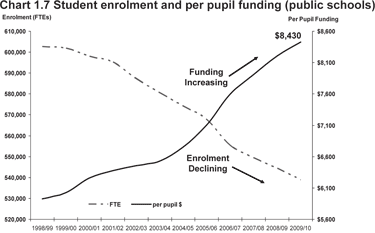
Post-Secondary Education
Budget 2007 continues to build on government's ongoing commitment to increase access to post-secondary education. Government recognizes
that BC faces significant challenges now and into the future with labour shortages in sectors such as health care, applied
sciences, engineering and trades. To help address these challenges Budget 2007 provides new funding of $343 million over three years beginning in 2007/08. This is in addition to $306 million allocated
in previous budgets, for a total funding increase of $649 million over the next three years. This increase includes funding
for negotiated settlements of $41 million in 2007/08, $87 million in 2008/09 and $133 million in 2009/10.
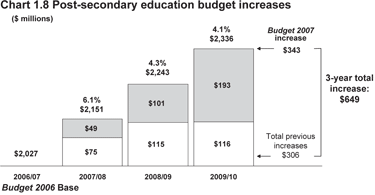
Budget 2007 reconfirms government's commitment to create, in partnership with the post-secondary sector, 25,000 new student spaces including
the commitment to create 2,500 new graduate spaces. Budget 2007 includes $82 million in new funding over three years for these initiatives to increase access to the post-secondary system.
An additional $20 million is being funded in 2006/07 to provide scholarships and internships to support the new and existing
graduate spaces.
In addition to enhancing general access to post-secondary education, government is committed to increasing Aboriginal participation
in post-secondary education and programming. The Ministry of Advanced Education will provide $15 million over the next two
years to plan and implement Aboriginal post-secondary service plans for institutions in collaboration with Aboriginal communities
and develop culturally enhanced curricula, programs and services.
To help train skilled workers supporting the province's growing mining industry, the Ministry of Advanced Education is contributing $2 million over the next two years to the Reclamation and Prospecting Program at Northwest Community College. This is a three
year pilot project initiated in 2006/07 in partnership with the federal government, the college and the Smithers Exploration
Group.
Through Campus 2020, the province is examining how to build on the strengths of the post-secondary system while discovering
new approaches to expand the network of learning opportunities across BC. The final report of Campus 2020, to be delivered
in the spring of 2007, will help inform government policy on post-secondary issues.
The province is also investing in the needs of future learners with the Children's Education Credit. Beginning in 2007, the
province will invest $1,000 for each new child born in the province, to contribute toward the cost of tuition and other related
educational expenses. More information on the Children's Education Fund can be found in the topic box on page 64.
Enhancing Social Services
Budget 2007 invests $468 million over four years on programs and services to enhance the quality of life for children, adults and families
living in British Columbia communities. This funding is targeted to programs and services to children and youth at risk or
with special needs, adults with developmental disabilities, and individuals and families in need.

Government continues to build on its ongoing investment in services to children and youth by providing $93 million to maintain
services to children at risk, and children with special needs. By 2009/10, up to an additional 1,200 children with special
needs will receive funding for intervention therapies and supports, and up to an additional 300 children with severe disabilities
or in the care of the province will receive essential medical equipment, therapies, and other medical benefits. This is in
addition to the investments made in Budget 2006 and the September Update which provided increased access to services by children and youth at risk or with special needs and their families.
Independent schools will receive additional grants of $43 million to increase the share of government funding of programs
that provide physical, health, intellectual and psychological services to students with special needs, giving families more
choices in their children's education.
Budget 2007 provides $32 million to fund rate increases to foster parents. Foster parents provide residential services for children in
the care of the Province. There are approximately 3,500 foster parents in British Columbia. These rate increases acknowledge
the increased financial pressures faced by these dedicated caregivers. This builds on additional support provided in April
2006, when the mileage allowance for foster parents was increased from $0.20 per kilometre to $0.30 per kilometre to reflect
higher transportation costs.
Budget 2007 also provides $15 million to fund the office of the Representative for Children and Youth. The Representative is a new independent
officer of the Legislature whose mandate is to advocate, monitor and report publicly on systemic issues across the child welfare
system, including critical injuries and deaths of children in care.
In 2005, the Province, First Nations Leadership Council and the federal government signed the Transformative Change Accord. The accord affirms the commitment of all parties to close the socio-economic gap between First Nations and other British
Columbians over the next ten years. Budget 2007 includes $10 million as part of government's action plan to deliver on this commitment.
Budget 2007 provides $47 million to increase income assistance rates for families with dependent children. Approximately 18,800 families
will see an increase to their monthly income assistance effective March 28, 2007. These increases are in addition to the general
increase in the shelter rate of $50 per month (see the topic box on Meeting the Housing Challenges of a Growing Economy on
page 19).
In addition to the shelter rate increase of $50 per month, $35 million has been provided to increase the income assistance
support rate for single employable clients by $50 per month, effective March 28, 2007. The combined increases will raise the monthly
income assistance rate for single employable clients by 20 per cent, from $510 per month to $610 per month. Approximately
16,300 individuals on income assistance will benefit from these rate increases. The support rate for single employable clients
was last increased in 2000.
The Ministry of Employment and Income Assistance will also receive an additional $51 million to provide for projected growth
in the number of persons with disabilities in 2008/09 and 2009/10. By 2009/10, the persons with disabilities caseload is projected
to grow by 9,765 cases or 16 per cent from 2006/07. This funding also provides for growth in supplementary assistance, including
health benefits and bus passes for low income seniors and persons with disabilities.
Budget 2007 invests $48 million in programs and services that assist individuals with developmental disabilities and their families. The
number of adults with developmental disabilities accessing residential and day support services and the acuteness of need
are increasing as a result of demographic trends and advancing technologies. This funding will provide new or continued access
to community living services for 1,600 adults with developmental disabilities and their families through additional respite
care, residential placements, and life skills training.
In addition, $10 million over three years is provided to increase rates for adult family care providers. Adult family care
homes provide residential services to developmentally disabled adults in a family setting. There are approximately 2,100 adult
family care homes in British Columbia.
Government is committed to ensuring the level and quality of community health and social services received by British Columbians
in need is sustainable. Budget 2007 provides $72 million to support contracted providers who provide services such as family development, services for children
and youth with special needs, adult community living services, victim services, employment programs for individuals on income
assistance, counselling services, and multi-cultural programs. An additional $37 million will be provided through the Ministry
of Health over three years to support contracted service providers in the health sector.
Budget 2007 also provides $12 million for responsible gambling programs and services, including increased access to counselling for those
with a gambling addiction. Currently, these programs serve approximately 1,200 clients annually.
Justice and Public Safety
Budget 2007 invests $178 million over four years to improve and transform the policing, justice and corrections system to protect communities
and citizens.
The BC justice system is provided with $38 million to improve access and security, and to enable transformation to meet the
needs of British Columbians:
- $12 million is allocated to transform the civil, family and criminal justice systems so that they continue to protect rights,
but seek solutions first, by integrating the justice system with other systems and disciplines in order to provide the public
with ways to resolve problems with little or no intervention by the courts, including:
- better delivery of counseling, legal information, legal advice, and other forms of resolution services;
- piloting a "hub" which will serve as a "front door" to the justice system where citizens can get services that will help them
get disputes resolved; and
- piloting community prosecution and other ways to engage communities in the criminal justice system (e.g. the Community Court
Pilot Project, scheduled to open in Vancouver in January 2008).
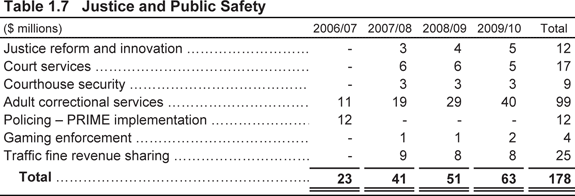
- $17 million is allocated to improve courthouse services, such as court administration, registry and trial support and security,
including $1 million to address the demand for additional court sittings in Fort St. John.
- $9 million is allocated for enhanced courthouse security, particularly for major or extraordinary trials and family court
matters.
Budget 2007 provides $99 million to manage the rising number of inmates in British Columbia correctional centres and the number of offenders
under community supervision. This funding will:
- provide for over 150 additional staff to improve security and maintain standards for inmate services, such as food and health
care, in correctional centres; and
- support an assertive case management strategy in community corrections that will manage the risk of re-offending and enhance
offender reintegration into the community.
Additional funding of $12 million is provided in 2006/07 to complete the implementation of PRIME (Police Records Information
Management Environment). PRIME is a real-time online data sharing system that provides police officers with instant access
to information about criminals and crimes. The additional funding will make the system available to an additional 3,300 RCMP
members in 103 detachments across the province.
Budget 2007 provides $4 million to enhance the regulation of gaming in British Columbia to protect the public from unscrupulous activity,
including investigating allegations such as cheating and money laundering.
Budget 2007 also provides $25 million for traffic fine revenue sharing, reflecting government's ongoing commitment to return 100 per cent
of net traffic fine revenue to participating local governments to improve policing and community safety.
Strengthening Communities
Budget 2007 reflects government's commitment to strengthen BC communities by investing $189 million in new spending from 2006/07 to 2009/10
for initiatives in areas such as local infrastructure, transportation and community meeting spaces:
- $14 million in additional funding for the Municipal Rural Infrastructure Fund, to provide investments in sustainable local
infrastructure to achieve cleaner water, cleaner air and a reduction of greenhouse gas emissions. This builds on $90 million
of provincial funding for local infrastructure previously committed for 2007/08 -2009/10.
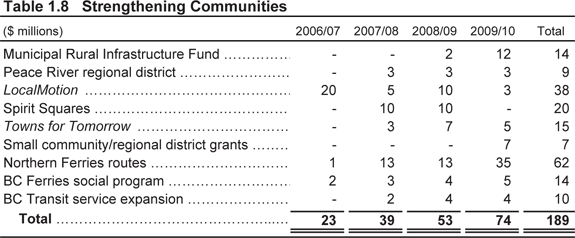
- $9 million for local infrastructure in the Peace River Regional District.
- $38 million for LocalMotion, to be invested in bike paths, walkways, greenways and accessibility improvements for persons with disabilities, which will
leverage an additional $38 million in local funding.
- $20 million for Spirit Squares, a program that will create or enhance outdoor public meeting spaces, with a focus on celebrating
BC2008, which will leverage an additional $20 million in local funding.
- $15 million for Towns for Tomorrow, a program targeting infrastructure investments in towns with populations under 5,000, which will leverage an additional
$4 million in local funding.
- $7 million to fulfill the provincial commitment to double small community grants to $54 million annually by 2009/10.
- $62 million for an increased service fee under a new agreement between the province and BC Ferry Services for accelerated
vessel replacements and terminal improvements, enhancing the service for communities served by the northern routes.
- $14 million to maintain provincial support for seniors, students and the disabled using coastal ferry services.
- $10 million for expansion of BC Transit services. This funding will provide an additional 66,700 service hours in 2007/08,
and 117,700 service hours in each of 2008/09 and 2009/10. The province is also providing $22 million in capital funding for
the purchase of 121 buses allowing 25 communities, including the Greater Victoria area, Kelowna, Chilliwack, Nanaimo and the
Central Fraser Valley to expand public transit services.
In addition, the province will flow $52.5 million from the federal Public Transit Capital Trust to the Union of BC Municipalities
in 2006/07 to help local governments reduce traffic congestion in urban areas, reduce carbon dioxide and other emissions,
and invest in public transit infrastructure.
Economic and Resource Development
Initiatives to facilitate and support economic growth are critical components of the provincial fiscal plan. These initiatives
include investments in skills and training, reconciliation of Aboriginal rights and title, and additional investments in the
natural resource sectors.
Skills and Training
In Budget 2007, government continues its commitments to enhance post-secondary educational and training opportunities throughout the province
by providing $315 million over four years towards ensuring that the province has a well-trained workforce for the future:
- The Industry Training Authority will receive $33 million to create an additional 7,000 apprenticeship spaces through public
and private training institutions by the end of 2009/10. This builds on the $39 million in funding provided in Budget 2006 to fund approximately 2,100 additional apprentice training spaces, help create 2,200 youth spaces in foundation programs,
establish three additional Industry Training Organizations, and update 20 industry training programs.
- Post-secondary institutions will receive $82 million in additional operating funding to support the creation of 25,000 new
student spaces including the commitment to create 2,500 new graduate spaces.
- $20 million will be provided in 2006/07 for scholarships and internships to support new and existing graduate spaces at BC
universities.
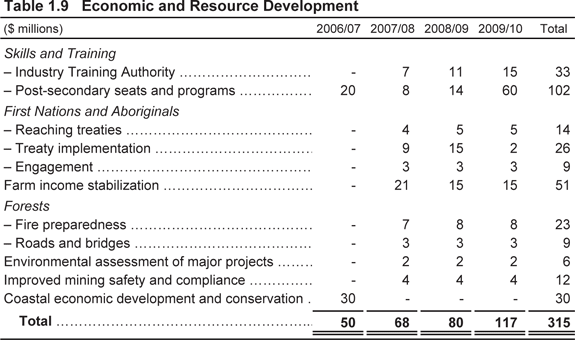
First Nations and Aboriginal People
Budget 2007 includes $49 million in funding for initiatives targeting reconciliation of aboriginal rights and title, as well as building
strong and respectful relationships between government and aboriginal organizations:
- $14 million for additional negotiations staff to accelerate treaty negotiations and complete other lasting agreements with
First Nations.
- Up to $26 million in additional resources may be provided to implement the recently initialled Maa-nulth, Tsawwassen and
Lheidli T'enneh Final Treaty Agreements, subject to ratification. This reflects funding that may be required for costs related
to ratification of the Final Agreements, transferring Crown lands and other benefits to the First Nations, and for additional
staff needed to carry out the province's legal obligations under the Final Agreements.
- $9 million for enhanced consultation and relationship building activities with aboriginal leadership, including the Leadership
Council and the Métis Nation of BC, and to increase engagement with aboriginal youth.
Natural resources are a vital component of the provincial economy. The province continues to invest in initiatives to facilitate
sustainable growth of this sector to provide opportunities for workers and communities:
- $51 million to fulfill the province's obligations under the Federal-Provincial Canadian Agriculture Income Stabilization program,
to stabilize farm incomes and ensure BC's continued food production capacity.
- $23 million for three additional long-term helicopter contracts and approximately 150 seasonal fire fighting positions to
increase the province's fire fighting capabilities.
- $9 million for repair and maintenance activities on non-industrial forest service roads and bridges, providing enhanced access
to rural communities, including First Nations communities, as well as recreation, tourism and smaller, community oriented
tenures across the province.
- $6 million for the Environmental Assessment Office to undertake environmental assessments throughout the province, ensuring
that project reviews are completed in a timely manner and continue to meet provincial standards.
- $9 million to hire new regional inspections staff to ensure the safety of mining operations and nearby communities, and to
protect the environment from the impact of expanded mining activities.
- $3 million to expand the province's geological mapping co-op program to provide data to support increased exploration and future
mine development projects.
- $30 million to fulfill government's commitment towards First Nation economic development and conservation management initiatives
within the central coast, north coast and Queen Charlotte Islands areas. The federal government has committed to contribute
$30 million and private contributors are also expected to partner, resulting in a total combined investment of $120 million
for these initiatives.
Budget 2007 also includes $200 million for Mountain Pine Beetle related initiatives, including $144 million for mitigating the impact
of the epidemic through the Forests for Tomorrow program, and $56 million for salvaging value from impacted and dead trees.
Environmental Leadership
Government is committed to initiatives that protect the environment and support the objective of leading the world in sustainable
environmental management. Budget 2007 includes $103 million to support environmental initiatives:
- $15 million for parks upgrades, including an expansion of recreation opportunities in selected parks, and updating water
systems, campground trails, and day use amenities in the most well-used BC parks.
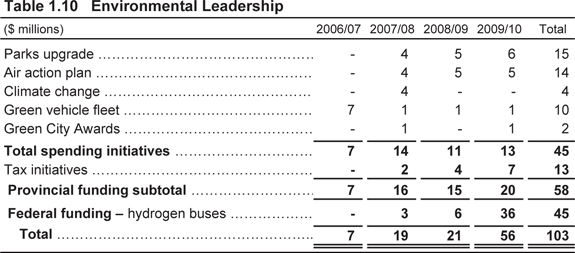
- $14 million to achieve air quality improvements in communities throughout the province. Planned initiatives include retrofitting
diesel buses, incentives to reduce the use of conventional wood stoves and encouraging industry to adopt better emission technologies.
- $4 million for climate change. This funding will support actions to reduce provincial greenhouse gas emissions and improve
the assessment of the impacts of climate change on BC.
- $10 million for the purchase of hybrid vehicles as part of the provincial government vehicle fleet.
- $2 million for the Green City Awards, highlighting achievements by local governments in greening their communities.
- $45 million in federal funding for hydrogen powered buses to be used by BC Transit.
In addition to the above spending initiatives, Budget 2007 includes $13 million of tax initiatives that support government's environmental objectives (for details on tax changes, see
Part 2 — Tax Measures).
This funding builds upon existing government commitments to environmental management, including $69 million for the investigation
and remediation of contaminated sites on Crown land and $8 million for the ongoing implementation of the drinking water action
plan.
Vancouver Convention Centre Expansion Project (VCCEP)
The Vancouver Convention Centre Expansion Project (VCCEP) represents a significant investment in tourism for the province.
The total budget for this project has been revised to $623 million from $615 million for the expansion, upgrades to the existing
Vancouver Convention and Exhibition Centre, and the connection of the existing and new facilities. The additional $8 million
is required to meet the escalated cost of contracts that must be committed to by the end of February 2007, to meet the project's
current schedule. Funding for the $623 million budget is from the following sources:
- the province ($280.5 million);
- the federal government ($222.5 million);
- Tourism Vancouver ($90 million); and
- upfront payments related to commercial agreements ($30 million).

Over time, Tourism Vancouver will reimburse the province for the $90 million contributed on its behalf.
At the time of writing, further work was underway to fully review and assess the impact of higher than expected construction
costs on the project. Preliminary estimates of an updated project cost are in the range of $800 million depending upon the
contract model selected. The capital contingency has been increased since Budget 2006 to reflect this pressure. Subject to government approval of a revised budget for VCCEP, funding will be allocated from the
capital contingencies to the project and reflected in subsequent quarterly reports and fiscal plans.
2010 Olympic and Paralympic Winter Games (2010 Olympics)
The province has committed $600 million towards funding of direct costs for the 2010 Olympics. This includes the provincial
contribution towards components that are jointly funded with the federal government including venue construction, security,
a venues operating endowment, live sites, and the Paralympic Games. It also includes the provincial commitment to medical
costs, First Nations, sports and municipal legacies, and a contingency allocation for potential unbudgeted costs. The provincial
contribution to venues includes a reallocation of $55 million from the contingency allocation within the $600 million envelope.
Budget 2007 includes $311 million for expenditures within the $600 million envelope from 2007/08 and 2009/10. In conjunction with expenditures
to the end of 2006/07, expenditures to the end of 2009/10 are expected to total $592 million. Budget 2007 also includes
contingencies allocations of $20 million in 2008/09 and $49 million in 2009/10 to cover potential unbudgeted
costs. This leaves $8 million remaining in the contingency allocation for 2010/11.

Transportation Investment Plan
Budget 2007 updates and builds on the government's three-year transportation investment plan. The province remains committed to securing
federal cost sharing on all eligible projects and programs, and leveraging additional investments through partnerships with
private partners.
Between 2007/08 and 2009/10 the updated transportation plan provides:
- $2.4 billion of provincial investment in transportation infrastructure; and
- $1.1 billion of investment leveraged through federal cost-sharing and partnerships with private partners, local governments
and other agencies.
The three-year transportation plan includes $491 million in provincial funding for the Gateway program. The Gateway program
has three key projects, the North Fraser Perimeter Road, South Fraser Perimeter Road and the Port Mann/Highway 1 project.
The federal Asia-Pacific Gateway Strategy and Corridor Initiative has provided an initial commitment of $192 million to the
North and South Fraser Perimeter Road projects. Bridge tolling remains a financing option for the Port Mann/Highway 1 project.
The province is committed to an overall provincial capital plan that is affordable today and in the future. In evaluating
affordability for taxpayers the province continues to monitor the capital spending and debt of all sectors, including the
transportation sector, while ensuring the growth in taxpayer-supported debt is less than growth in the provincial economy.
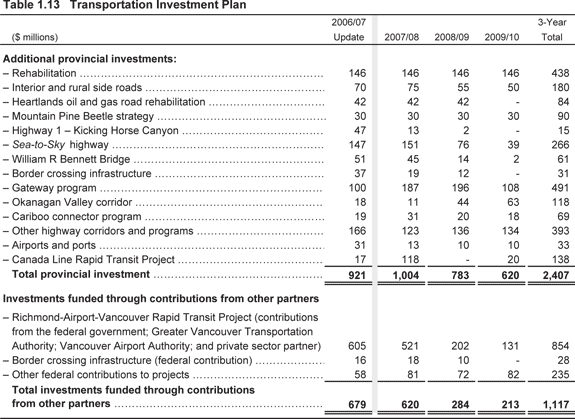
Expenses Recovered from External Entities
Expenses recovered from external entities are expected to increase by $380 million in 2006/07 compared to the projection in
Budget 2006, primarily due to federal funding received for one-time projects. These include $73 million for Mountain Pine Beetle mitigation, $56 million for housing projects, $52 million for local transportation capital, and $54 million for scholarships and study
grants.
For 2007/08 and 2008/09, the Budget 2007 projections are $113 million and $78 million higher, respectively, than last year, reflecting the multi-year nature of certain
of the above mentioned projects. For 2009/10, recovered expenses are projected to increase by $74 million over 2008/09, mainly
due to the additional recovery of interest costs from BC Hydro resulting from its borrowing for capital expenditures.
Service Delivery Agency Expenses
Service delivery agency net spending (i.e. expenses in excess of government transfers) is forecast to increase by $232 million
in 2006/07 and $267 million in 2007/08, and decrease by $39 million in 2008/09 when compared to the projections in Budget 2006. Net spending in Budget 2007 is expected to increase by $249 million between 2008/09 and 2009/10.
Projected net spending by school districts is up $52 million in 2006/07, $65 million in 2007/08 and $17 million in 2008/09
due to spending increases funded through increases in own source revenues, such as investment earnings. In Budget 2007, the net spending of school districts remains almost unchanged between 2008/09 and 2009/10.
Projected net spending by universities and colleges is up $38 million and $2 million in 2006/07 and 2007/08 and down $60 million
in 2008/09. The increase in 2006/07 reflects additional faculty for education and research programs. The net spending decrease
in 2008/09 reflects additional post-secondary funding grants from the Ministry of Health for additional spaces for medical
residents and funding provided by the Ministry of Advanced Education through allocations within its existing budget.
In Budget 2007, the net spending of universities and colleges is expected to increase by $58 million between 2008/09 and 2009/10 mainly
due to the impact of increased enrolment on ancillary operations such as housing and food services.
Projected net spending by health authorities and hospital societies is up $158 million in 2006/07 and $220 million in 2007/08
in part reflecting deficits forecast by the Vancouver Coastal and Fraser Health Authorities.
The 2006/07 forecast update and the 2007/08 fiscal plan reflect updated projections from health authorities and hospital societies.
Health authorities have projected deficits totaling $38 million for 2006/07 (Vancouver Coastal Health Authority, including
Providence — $40 million, partially offset by a small surplus at the Northern Health Authority). Two health authorities have
also projected deficits for 2007/08 totaling $119 million (Vancouver Coastal Health Authority $54 million; Fraser Health Authority $65 million). As both of these health authorities recently had new board chairs appointed, their boards did not have sufficient
time to review the earlier forecasts in detail prior to the budget. The boards of the Vancouver Coastal and Fraser Health
Authorities are currently reviewing the authorities' financial plans and are expected to submit revised financial plans in
early fiscal 2007/08.
Funding for the health authorities is focused on the 2007/08 fiscal year. In addition to their operating grants, the health
authorities will have access to a new $100 million fund in 2007/08 to promote innovation and facilitate change within the
healthcare system.
In 2008/09 and 2009/10, health authority operating grants include funding increases for settlement costs under the negotiating
framework. This is for planning purposes only. The Ministry of Health will continue to work with the health authorities on
their financial plans in the context of the Conversation on Health. The Ministry of Finance will continue to monitor and review
these financial plans as part of budget processes.
To ensure that the Province's three-year fiscal plan remains balanced, the forecast allowances for 2008/09 and 2009/10 recognize
the interim nature of the health spending targets and can accommodate some additional growth in health authority funding.
Projected net spending by children and family development agencies and authorities for 2006/07 and 2007/08 is only slightly
changed from the projections for the same years in Budget 2006. For 2008/09, net spending is $30 million lower compared to Budget 2006 due to a change in the approach for the transfer of services and in the timing for establishing the aboriginal authorities.
Net spending by children and family development agencies and authorities shows only a slight increase between 2008/09 and
2009/10, as Budget 2007 projections continue to reflect only the activities of Community Living BC and the expenses of the interim aboriginal authorities
pending finalization of the transfer of services.
The projected net spending of other service delivery agencies for 2006/07 to 2008/09 is virtually unchanged from the projections
for the same years in Budget 2006. Net spending by these agencies is expected to increase by $187 million in 2009/10, mainly due to increased costs for the
BC Transportation Financing Authority resulting from the infrastructure program.
Revenue
Government revenue includes the combined revenues of the CRF, taxpayer-supported Crown agencies, the SUCH sector, and the
net income of commercial Crown corporations. Budget 2007 includes the effects of tax cuts mainly targeted at families and individuals, including measures to increase the affordability
of housing for British Columbians.
Budget 2007 Plan
Following growth of 7.7 per cent in 2005/06, revenue is forecast to total $38,040 million in 2006/07, up 5.8 per cent. The
2006/07 forecast includes the effects of 5.9 per cent nominal GDP growth in 2006 resulting in improved taxation revenue, increasing
federal transfer payments (including one-time federal trusts) and commercial Crown net income. These improvements are partially
offset by the impacts of lower natural gas prices and tax measures introduced since Budget 2006.
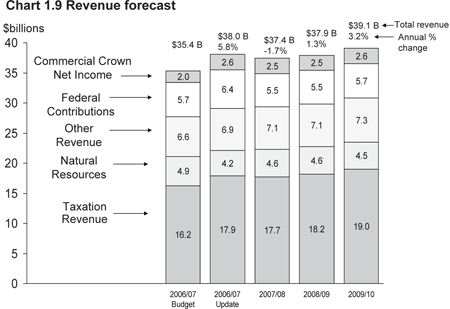
In 2007/08, revenue is forecast to decline 1.7 per cent or $650 million, reflecting $426 million of tax measures announced
in Budget 2007, lower equalization and other federal government transfers partially offset by higher natural gas royalties as prices are
expected to rise from the relatively low levels in 2006/07 due to mild winter weather patterns. For more details on tax initiatives,
see Part 2: Tax Measures.

Revenue increases 1.3 per cent or $480 million in 2008/09 as the effects of 4.9 per cent nominal GDP growth is partially offset
by the second stage of personal income tax cuts, lower forest revenue and the effects of falling coal and metal prices.
In 2009/10, revenue growth of 3.2 per cent or $1,205 million incorporates the impacts of 5.0 per cent nominal GDP growth and
the partially offsetting effects of declining energy and metal prices.
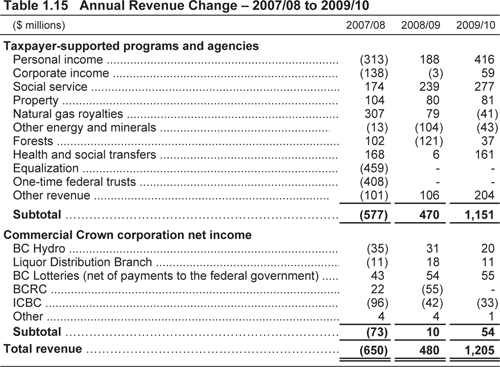
Key assumptions and sensitivities relating to revenue are provided in Appendix Table A10. The major revenue components are:
- Personal income tax — down $313 million in 2007/08, and rising $188 million and $416 million over the next two years.
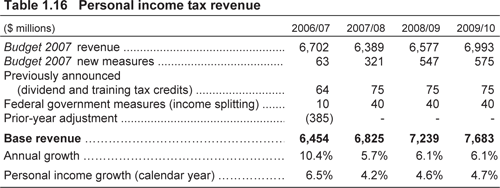
- Excluding the one-time prior year adjustment in 2006/07 due to higher 2005 personal tax remittances and adding back the tax
measures, base revenue is forecast to grow 10.4 per cent in 2006/07 and average 6.0 per cent over the next three years in
line with the strong economic growth in 2006 that is expected to moderate but remain solid in the revised three-year plan.
- Corporate income tax — down $138 million and $3 million in 2007/08 and 2008/09 and up $59 million in 2009/10. Corporate income tax revenue is recorded
on a cash basis including federal government advance installments with adjustments for over/under payments made in the following
year, consistent with the Tax Collection Agreement.

- Revenue is lower in all three years of the updated fiscal plan compared to 2006/07 as the prior-year adjustment declines over
the 2007/08 to 2009/10 period. As BC's payment share increases over the four years reflecting stronger BC economic growth compared
to the national average, federal installment payments rise faster than entitlement and the prior-year adjustment is expected
to decline. By 2008/09, advance payments are roughly equal to entitlements, resulting in a small $2 million prior-year adjustment
in 2009/10.
- Social service tax — after adjusting for $48 million of one-time revenue in 2006/07 and measures introduced in Budget 2007, growth is forecast to average 5.2 per cent over the next three years, in line with expected consumer and business spending.
For full details on tax measures, see Part 2: Tax Measures.
- Property tax — increasing $104 million in 2007/08 and about $80 million in the next two years mainly reflecting the introduction of a small
community/rural tax of $25 million in 2007/08 and 4.3 per cent average growth in the next two years, in line with expected
inflation and new construction activity.
- Natural gas royalties — rising $307 million and $79 million in the first two years and declining $41 million in 2009/10 reflecting changes in natural
gas prices over the four years. The average price (Canadian dollars per gigajoule at plant inlet) rises by $0.85 to $6.50
in 2007/08 and $0.20 to $6.70 in the following year before falling $0.21 to $6.49 in 2009/10. Volumes are expected to average
1.9 per cent growth over the fiscal plan. The government continues to offer oil and gas royalty credits to encourage industry-driven
infrastructure investment that will generate further oil and gas exploration. See the Natural Gas Prices topic box for more
details regarding natural gas markets and price forecasts.
- Other energy and minerals — declining in each of the next three years due to the effects of commodity prices falling from the high levels occurring
in 2006/07.
- Forests — increasing in 2007/08 due to the full year impact of the softwood lumber border tax collections and rising stumpage revenues
as lumber prices begin to recover.
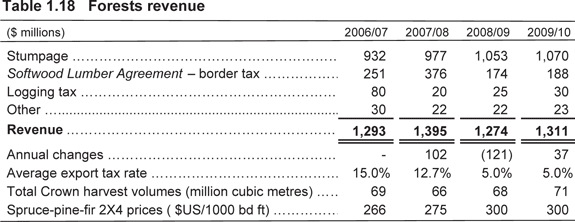
- The $121 million decline in 2008/09 reflects the decline of softwood border tax revenues as prices recover to US$300 and the export tax rate falls to 5 per cent, offsetting the rising stumpage revenues due to higher prices and harvest volumes.
- Health and social transfers — increases by $168 million in 2007/08 reflecting a higher BC share of the national population and an increasing federal base.
Growth is relatively flat in 2008/09 as the effects of an increasing national health base and higher BC population share are
offset by declining deferred revenue and the recent decision by the federal government to fund social programs at 2007/08
levels. In 2009/10, growth is more in line with the historical trend except for social transfer entitlement.
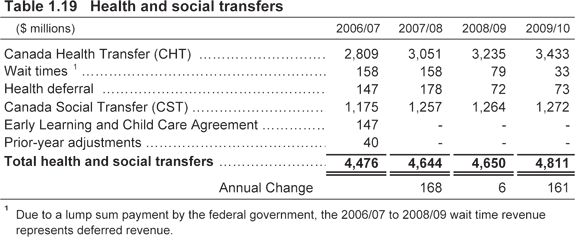
- Equalization — forecast to be zero in 2007/08 and future years, based on the latest information from the federal government. More details
are expected to be available with the release of the federal budget.
- One-time federal trusts — established by the federal government in 2006/07 for capital projects related to post-secondary infrastructure, public transit,
affordable housing and off-reserve aboriginal housing.
Changes from Budget 2007 Consultation Paper
Compared to the Budget 2007 Consultation Paper fiscal plan, revenue before tax reductions announced in Budget 2007 are up $1,709 million, $673 million, $713 million and $804 million over the 2006/07 to 2009/10 period reflecting:
- one-time effects in 2006/07 including an additional $194 million prior-year adjustment mainly due to higher 2005 personal
income tax remittances and federal government trusts totaling $408 million to fund capital projects in BC.;
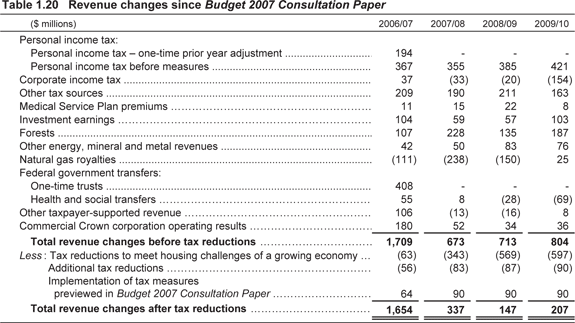
- the effects on tax and other own-source revenues (excluding natural resources) of robust economic growth over the three years;
- higher forests revenue mainly reflecting border tax revenue collected by the federal government and remitted to BC, resulting
from the Softwood Lumber Agreement 2006;
- improved revenue from other energy, mineral and metal sources mainly due to stronger metal prices — especially copper; and
- higher commercial Crown incomes mainly attributable to improved outlooks for BC Hydro (primarily due to lower energy and
financing costs, and the introduction of regulatory account transfers as part of net income) and ICBC (mainly due to higher
premium revenue, increased investment income and lower insurance operations costs). Future rate assumptions for BC Hydro are
disclosed in Appendix Table A10.
These improvements are partially offset by:
- tax reduction measures announced in Budget 2007;
- the impact of lower natural gas prices; and
- reduced social transfers in 2008/09 and 2009/10 reflecting the recent decision by the federal government to reduce Canada
Social Transfer funding to 2007/08 levels.
Commercial Crown Corporation Income
- British Columbia Hydro and Power Authority — BC Hydro's net income projections for the Budget 2007 fiscal plan reflect higher domestic demand and the recent BCUC decision on BC Hydro's revenue requirements for 2006/07 and
2007/08. While new sources of supply will result in lower market purchases to meet domestic demand, energy costs are expected
to increase as the new sources of supply are more expensive than existing Heritage energy. BC Hydro is also projecting increased
operating, amortization and financing costs due to their capital asset improvement program. Future rate assumptions for BC
Hydro are disclosed in Appendix Table A10.
- British Columbia Liquor Distribution Branch (LDB) — LDB's projections for the Budget 2007 fiscal plan reflects a slight decrease in market share and net income in 2007/08 due to the increase in the discount rate
for licensee retail stores. Market share is expected to stabilize by 2008/09, with normal sales volume growth resulting in
higher net income in the last two years of the fiscal plan.
- British Columbia Lottery Corporation — BCLC's projections for the Budget 2007 fiscal plan reflects continued strength in casino revenue and a resurgence of lottery and bingo gaming, partially offset
by increasing costs for prizes, commissions and operations that support the revenue growth.
- A significant portion of BCLC's transfers to government is redistributed to charities and local governments. In Budget 2007, these distributions are projected to increase from $238 million in 2006/07 to $263 million in 2009/10.
- British Columbia Railway Company — In its Budget 2007 outlook, BCRC anticipates the sales of residual properties will occur by the end of 2007/08. BCRC will continue to operate
the Port Subdivision (Robert's Bank) in support of government's ports and gateway strategies.
- Insurance Corporation of British Columbia — ICBC's outlook for the Budget 2007 fiscal plan reflects both strong vehicle growth and increasing claims costs. The outlook projects annual increases to basic
insurance rates to cover expected claims and operating costs, and to maintain capitalization. (Actual basic rate increases
are subject to BCUC approval.) The projected revenue improvements are offset by significant increases in claims costs, primarily
due to a continuing trend of higher costs from injury claims, including an increase in legal tariff costs effective January 1, 2007.
Full-Time Equivalents (FTEs)
Taxpayer-supported FTEs, including ministries/special offices (CRF) and service delivery agencies, are projected at 34,391
in 2007/08. This represents an increase of 1,198 FTEs from 2006/07 and is 1,092 FTEs higher than the 2007/08 projection in
Budget 2006. The increase reflects additional resources to address service expansion including court services, corrections, adult community
living services, paramedics and forest fire preparedness.
By 2009/10, FTEs are projected to increase a further 316 to total 34,707 FTEs. Table 1.21 provides details of changes from
Budget 2006. FTEs of the SUCH sector are not included in these forecasts.
Ministries/special offices (CRF)
The 2007/08 FTEs projection for ministries and special offices is 30,416 FTEs — a net increase of 1,235 FTEs from Budget 2006. The increase primarily reflects government's priority to build internal capacity in a number of areas, including additional
resources for court services, corrections, adult community living services, children at risk or with special needs, paramedics
and forest fire preparation.
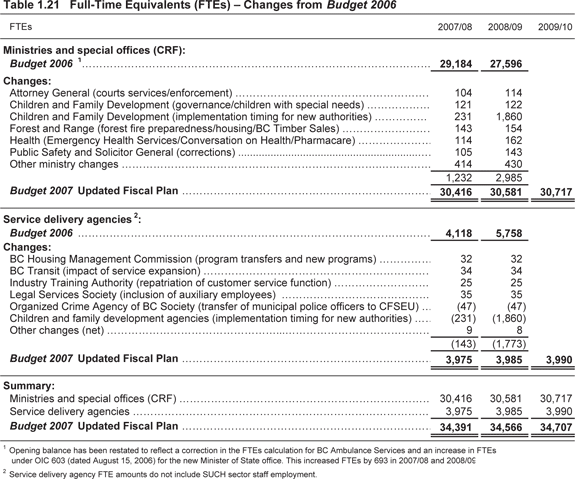
Service delivery agencies
The 2007/08 service delivery agencies FTE projection is 3,975 — a decrease of 143 FTEs from Budget 2006. The reduction is primarily due to a change in the timing of when regional children and family authorities are expected to
assume responsibility for delivery of services, partially offset by an increase in resources for other service delivery agencies
(see Table 1.21). By 2009/10, service delivery agency FTEs are projected to increase by only 15. Future allocations to the
children and family development authorities will be identified when the timing of the regional program transfers is finalized.
Capital Spending1
In addition to funding municipal and regional infrastructure delivered by local governments, the province also invests directly
in capital infrastructure to provide services to the public and facilitate economic development. Provincial capital infrastructure
investments are made through school districts, health authorities, post-secondary institutions, Crown agencies and ministries.

The rising infrastructure demands of a growing economy coupled with inflationary pressures on existing capital projects requires
government to be diligent in ensuring that capital and debt are affordable over the long term. To achieve this, government
is committed to maintain a downward trend in the taxpayer-supported debt to GDP ratio, using a three-year moving average. This
ratio is a key measure often used by financial analysts and investors to assess a province's ability to repay debt.
Additional information on the provincial capital plan and debt management is provided in the topic box on page 66.
Taxpayer-supported capital spending
Taxpayer-supported capital spending includes capital infrastructure for school districts, health authorities, post-secondary
institutions, taxpayer-supported Crown agencies, and ministries.
The capital spending numbers for health and education reflect the forecasts for health authorities, school districts and post-secondary
institutions. Annual interest costs on capital related debt, as well as estimates of asset depreciation are also charged against
government's surplus.
Taxpayer-supported capital spending is projected at $3.9 billion in 2007/08 before declining to $2.9 billion in 2009/10. Significant
elements of this projected spending include the following:
- Continued management of the $1.5 billion program to seismically upgrade at-risk schools in the province. A long-term plan
for the program is currently being developed by the Ministry of Education in conjunction with school boards. The province
is providing over $867 million in capital funding from 2007/08 to 2009/10 to replace, renovate or expand K–12 facilities.
- The 25,000 seat expansion to the post-secondary system has significant implications on institutional facilities now and into
the future. This need to accommodate the government's growth plan, replace or renovate aging facilities and develop new research
capacity and infrastructure requires substantial capital funding contributions from the Province. Budget 2007 includes over $700 million in capital funding to post-secondary institutions throughout the province. Projects funded include
the Engineering and Computer Science Complex at the University of Victoria, the Teaching and Learning Centre at UNBC, the
BCIT Aerospace Technology Campus and the Cloverdale Trades and Technology Campus.
- Post-secondary capital spending also includes a significant level of investment funded through other sources, including foundations,
donations, cash balances, federal funding and revenues generated from services. Examples of projects financed wholly or partially
through such sources include Marine Drive student housing at UBC, the Arts and Social Sciences Complex at SFU, the Second
Technology and Science Complex and various parking structures and student residences planned at various campuses throughout
the province.
- The Ministry of Health will also provide $1.2 billion (including federal equipment funding) in capital grants to health authorities
for new major construction and upgrading of health facilities, equipment, and information systems over the next three years.
Including funding from own sources, such as Regional Hospital Districts and Foundations, this will support a total capital
spending plan for the health sector of approximately $2.1 billion over the next three years.
- Examples of major capital projects include:
- Construction of a new ambulatory care facility in Surrey (the Surrey Outpatient Facility), scheduled to be completed in 2009.
- Residential care and Assisted Living projects to support seniors and people with disabilities throughout the province.
- New academic space in teaching hospitals throughout BC, including Prince George Regional Hospital, and planning is underway at Kelowna General Hospital to support medical school expansion.
- Expansion of the Shuswap Lake General Hospital in Salmon Arm, scheduled to be completed in 2009.
- Construction of a new Perinatal Wing at Nanaimo Regional General Hospital.
- Replacement of St. Bartholomew's Health Centre in Lytton.
- Completion of the Vancouver General Redevelopment Project in 2007/08.
- Expansion and upgrade of the Pediatric Intensive Care Unit at Children's and Women's Hospital in Vancouver.
- Abbotsford Regional Hospital and Cancer Centre P3 Project, expected to be completed in May 2008.
- Investments in new and replacement medical and diagnostic equipment such as MRI and CT scanners.
- Information management and technology projects including, for example, diagnostic imaging systems and clinical information systems.
- province-wide eHealth initiatives such as Telehealth and the Electronic Health Record.
- Key hospital projects identified by health authorities in Victoria, Kelowna, Vernon, and Fort St. John. Recognizing their importance to the provincial health system, government has set aside a preliminary allocation within capital contingencies to assist the health authorities in financing these projects.
- Ongoing commitment to the Transportation Investment Plan (see page 37 for more information) which will provide $3.5 billion
of public and private sector investment over the next three years. Under the plan, provincial capital spending for 2007/08
to 2009/10 is directed towards initiatives such as Phase 2 of the Kicking Horse Canyon Project, the new Pitt River Bridge
component of the Gateway Project, the Sea-to-Sky Highway improvements, the William R. Bennett Bridge, and funding to support road rehabilitation benefiting the oil and gas
sector and additional road rehabilitation to manage the impacts of intense harvesting required under the Mountain Pine Beetle
Strategy.
- The Vancouver Convention Centre Expansion Project (VCCEP). Capital spending for VCCEP on Table 1.22 is based on the total
capital cost of the VCCEP, reflecting the funding provided by all partners; the province, the federal government, and Tourism
Vancouver. Table 1.23 shows the capital expenditures for the VCCEP associated with provincial financing only, which totals $281 million. Table 1.11 provides the timing and amount of provincial funding grants provided to the VCCEP. These grants are
eliminated in the summary financial statements, so that only the total capital expenditures of the VCCEP are reported in the
government financial statements.
- At the time of writing, further work was underway to fully review and assess the impact of higher than expected construction costs on the project. Preliminary estimates of an updated project cost are in the range of $800 million depending upon the contract model selected. The capital contingency has been increased since Budget 2006 to reflect this pressure. Subject to government approval of a revised budget for VCCEP, funding will be allocated from the capital contingencies to the project and reflected in subsequent quarterly reports and fiscal plans.
Capital Contingencies
Recognizing that rising construction costs are currently a concern, the province has included a capital contingency averaging
9.5 per cent of total taxpayer-supported capital spending in its three-year capital plan as a prudent planning measure. This
contingency is in addition to the contingencies included in individual project budgets.
In addition to covering risks from higher than expected cost inflation on projects including VCCEP, the capital contingency
includes a preliminary allocation for hospital projects in Victoria, Kelowna, Vernon and Fort St. John.
Should the capital contingency not be used in any year, taxpayer-supported debt will be lower.
Provincial capital infrastructure spending is financed through a combination of sources:
- cash balances;
- partnerships with the private sector (public-private-partnerships);
- cost-sharing with partners; and
- borrowing (debt financing).
Debt financing continues to represent a significant source of financing for provincial capital spending, so the level of capital
spending has a significant impact on projected provincial debt.
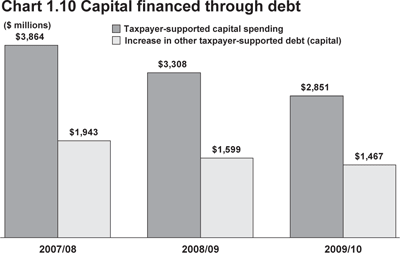
Self-supported capital spending
Total capital spending includes capital infrastructure for self-supported commercial Crown corporations.
Self-supported capital spending is projected to range from $1.3 billion in 2007/08 to $1.7 billion in 2009/10. The majority
of this capital spending is for electrical generation, transmission and distribution projects carried out through BC Hydro
and BC Transmission Corporation to enhance reliability, public safety and growing demand. In addition to the projects shown
on Table 1.23, other examples of electrical generation, transmission and distribution projects included in self-supported capital
spending are the Mission-Matsqui Transmission Reinforcement Project, a new substation in Abbotsford, and upgrades to the GM
Shrum generating station on the Peace River and the John Hart generating station on Vancouver Island.
Further details on provincial capital investments are shown in the service plans of ministries and Crown corporations.
Projects over $50 million
As required under the Budget Transparency and Accountability Act, major capital projects with multi-year budgets totaling $50 million or more are shown in Table 1.23. Annual allocations
of the full budget for these projects are included as part of the provincial government's capital investment spending shown
in Table 1.22.
Over the next three years, over $1.2 billion of provincial funding will be spent on major capital investments (greater than
$50 million) including:
- $269 million for the Abbotsford Regional Hospital and Cancer Centre and the Surrey Outpatient Facility.
- $434 million for major transportation capital infrastructure. In addition, the Ministry of Transportation is investigating
financial and project delivery options through P3s for improvements to Lower Mainland infrastructure. Provincial funding for
the RAV project is not included in the province's capital spending, but is included in the transportation investment plan.
- $347 million for power generation and transmission capital projects by BC Hydro, BC Transmission Corporation and the Brilliant
Expansion Power Corporation.
- $169 million for other projects including the revised provincial cost for the Vancouver Convention Centre Expansion Project,
and tenant improvements for Surrey Central City (ICBC Properties Ltd.).
Projects completed during 2006/07 include SFU's Surrey Central City campus, the Gordon and Leslie Diamond Health Care Centre
(previously called the Academic Ambulatory Care Centre), 5 Mile (Yoho) Bridge, Nisga'a Highway, and SkyTrain extension. Since the second Quarterly Report, the Surrey Outpatient Facility, the GM Shrum stator replacement and Peace Canyon turbine overhaul power projects have been
added to the $50 million list.
Table 1.23 identifies the provincial share of funding for major capital projects (over $50 million). However, total costs
for some of these projects are higher as they are cost-shared with the federal government, municipal authorities or the private
sector.
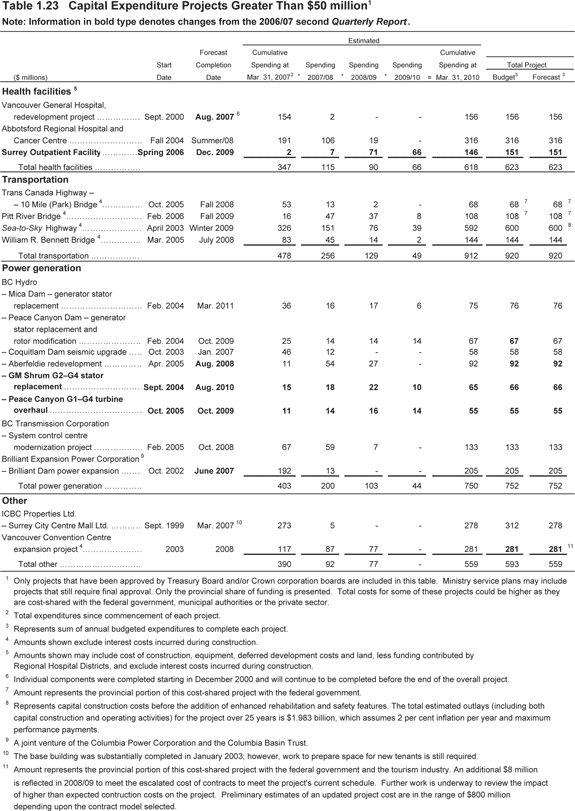
Provincial Debt
The provincial government along with its Crown corporations and service delivery agencies provide services and capital infrastructure
to support the social and economic programs needed for maintaining and enhancing the quality of life in BC. Funding for these
programs is mainly derived from revenue sources such as taxation and the sale of natural resources. Government also obtains
financing from outside sources mainly through debt issuances that are to be repaid on future dates.
Borrowing for operations is required to finance deficits and to meet other working capital requirements such as loans and
advances or changes in accounts receivable/payable. This type of debt (government direct operating debt) tends to rise during
periods of deficits, but declines with surpluses. Government operating debt is forecast to decline by $2.4 billion over the
next three years reflecting continuing surpluses.
Borrowing for capital projects finances the building of schools, hospitals, roads and other social and economic assets. As
these investments provide essential services over several years, the government, like the private sector, borrows to fund
these projects and amortizes the costs over the assets' useful life.
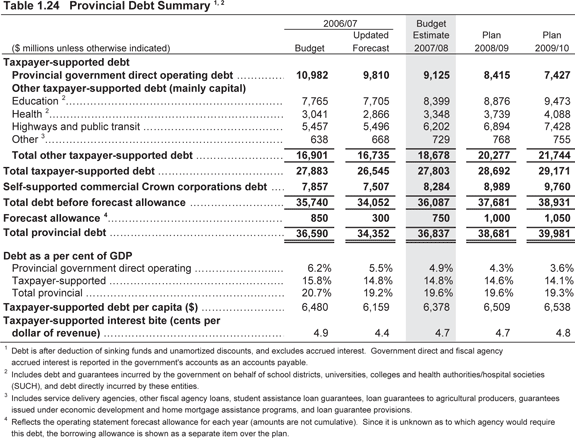
In 2006/07, provincial debt is forecast to total $34.4 billion, $2.2 billion below budget. In 2007/08, provincial debt will
increase $2.5 billion from the 2006/07 updated forecast to total $36.8 billion. The 2007/08 change reflects:
- a $1.3 billion increase in taxpayer-supported debt reflecting a $1.9 billion increase in other taxpayer-supported debt mainly
to finance net capital requirements, offset by a reduction in operating debt;
- a $777 million increase in commercial Crown corporation debt, mainly to fund power generation and transmission capital projects
by BC Hydro and BC Transmission; and
- a $450 million increase in the forecast allowance to mirror the $750 million income statement forecast allowance.
Over the next two years, government direct operating debt is forecast to decrease $1.7 billion reflecting continued surpluses,
while other taxpayer-supported debt will increase $3.1 billion mainly to finance capital requirements.
Self-supported debt will increase $1.5 billion over 2008/09 and 2009/10, mainly to fund power generation and transmission
projects. Government and BC Hydro are currently reviewing the corporation's debt management policies — including the legislated
debt cap and debt-to-equity target — to optimize fiscal efficiency while providing flexibility to refurbish aging infrastructure
and expanding capacity to support the province's economic growth.
The debt forecast assumes a forecast allowance of $750 million in 2007/08, increasing to $1,000 million in 2008/09 and $1,050 million in 2009/10 to mirror the operating statement forecast allowance. Should the government not require this allowance,
projected debt levels under the fiscal plan would be lower by the amount of the forecast allowance for each year.
In general, the change in debt will not equal the surplus:
- as debt is required to finance capital spending in excess of non-cash amortization costs included in the surplus; and
- due to other working capital sources/requirements that represent changes in balance sheet items (such as cash balances, loan
receivables and other accounts receivables/payables), but do not form part of the surplus.
Table 1.25 reconciles forecast surpluses with changes in debt. There is not a dollar for dollar relationship between changes
in direct operating debt and the surplus or deficit due to changes in other balance sheet items. In the updated fiscal plan,
debt rises despite expected surpluses mainly due to the impact of capital spending in excess of amortization, and higher commercial
Crown corporation debt incurred for capital investments.
The ratio of taxpayer-supported debt, which excludes commercial Crown corporations and other self-supported debt, to GDP is
a key measure often used by financial analysts and investors to assess a province's ability to repay debt. The government is
committed to maintaining a downward trend in this ratio, using a three-year moving average.

The taxpayer-supported debt to GDP ratio is forecast to decline from 14.8 per cent in 2007/08 to 14.6 per cent in 2008/09
and to 14.1 per cent in 2009/10, keeping debt affordable for future generations of British Columbians.
The decline in the taxpayer-supported debt-to-GDP ratio reflects the $630 million improvement in taxpayer-supported debt in
2006/07, operating surpluses over the next three years, and higher GDP forecasts. However, taxpayer-supported interest costs
are expected to rise to 4.8 cents per dollar of revenue by 2009/10, due to higher interest rates and increased taxpayer-supported
capital debt.
The higher than expected surpluses over the past few years have allowed the province to make significant investments in infrastructure
without adding to provincial debt. For example, the $3.06 billion surplus in 2005/06 and the $2.85 billion surplus in 2006/07
helped finance the following projects:
- $1.61 billion spending on post-secondary facilities including the University of Victoria's Engineering and Computer Science
Building, and the North Cariboo Community Campus in Quesnel;
- $0.65 billion in spending in the K–12 school system including Pacific Heights Elementary school in Surrey, and L'Ecole Victor
Brodeur in Esquimalt;
- $1.70 billion for health facilities and equipment including cancer treatment vaults at the BC Cancer Agency's Vancouver Centre,
and the Mental Health Building for Children at BC Children's and Women's Hospitals; and
- $1.60 billion for roads and bridges including the Cariboo connector program, Kicking Horse Canyon Phase I, and the Yoho bridge.
However, with smaller surpluses forecast from 2007/08 through 2009/10, debt-financing is required to fund the provincial capital
spending program.
Table 1.26 summarizes the provincial financing plan for 2007/08. New borrowing of $5.3 billion is anticipated, of which $2.8 billion will be used to replace maturing debt and $2 billion will be used for capital and other financing requirements. The
remaining $450 million reflects an increase in the debt forecast allowance.
Additional details on the debt outstanding for government, service delivery agencies and commercial Crown corporations are
provided in Appendix Tables A15 and A16.
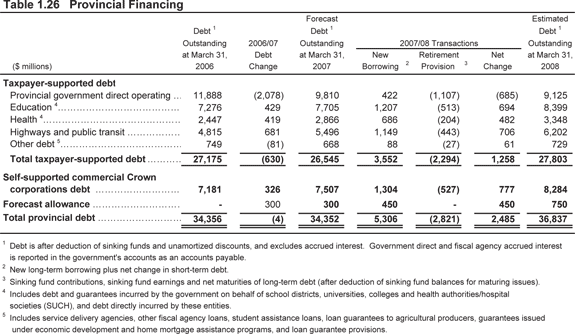
Risks to the Fiscal Plan
The major risks to the fiscal plan stem mainly from changes in factors that government does not directly control. These include:
- Assumptions underlying revenue and Crown corporation and agency forecasts such as economic factors, commodity prices and
weather conditions.
- The outcome of litigation, arbitrations, and negotiations with third parties.
- Potential changes to federal transfer allocations, cost-sharing agreements with the federal government and impacts on the
provincial income tax bases arising from federal tax policy changes.
- Utilization rates for government services such as health care, children and family services, or employment assistance.
In addition, changes in accounting treatment or revised interpretations of generally accepted accounting principles (GAAP)
could have material impacts on the bottom line.
Table 1.27 summarizes the approximate effect of changes in some of the key variables on the surplus. However, individual circumstances
and inter-relationships between the variables may cause the actual variances to be higher or lower than the estimates shown
in the table. For example, an increase in the US/Cdn dollar exchange rate may be offset by higher commodity prices; or as
is forecast in 2006/07, significantly reduced natural gas revenues, can be offset by positive variances in other areas, such
as taxation revenues, federal transfers and other improvements.
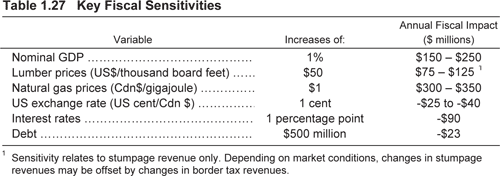
Contingency Vote
Contingencies — General Programs
A $360 million Contingency vote for general programs is included in the 2007/08 fiscal year. This is increased to $365 million
in 2008/09 and $375 million in 2009/10 representing roughly 1 per cent of overall government expense. These amounts include
the $68.5 million allocation of the remaining $76.5 million 2010 Olympics contingency budget.
The allocation to contingencies is a prudent budgeting measure that protects the three-year fiscal plan from:
- unforeseen and unbudgeted costs that may arise (such as unexpected environmental remediation costs); and
- pressures for costs that are currently budgeted based on estimates whose final value are impacted by external events or prices
(such as payments made under the Vancouver Island Gas Pipeline Assistance Agreement that are directly linked to natural gas
prices).
In addition to these specific items, corporate pressures such as the valuation of employer contributions to pension plans
may also impact the contingency vote.
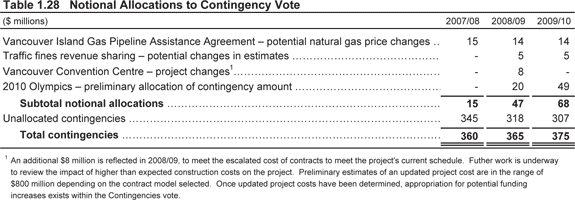
Contingencies — Negotiating Framework
Budget 2007 includes $39 million in 2007/08, $77 million in 2008/09 and $142 million in 2009/10 for the wage and benefit impacts for agreements
yet to be concluded. These amounts are held in contingencies and will be distributed by the Minister of Finance once settlements
are reached.
Contingencies — Health Innovation Fund
A new $100 million fund to promote innovation and facilitate change within the healthcare system is included in Budget 2007. The Health Innovation Fund will assist health authorities with the cost of implementing best practices, restructuring service
delivery systems and eliminating key information bottlenecks.
Forecast Allowance
In 2007/08, the government continues to build a forecast allowance into the bottom line to act as a cushion against possible
deterioration in revenue or spending forecasts, and thus increase the certainty of meeting the surplus targets established
in the fiscal plan.
A forecast allowance of $750 million is included in the 2007/08 budget. This forecast allowance has the explicit effect of
reducing the expected surplus from the government's most likely forecast of $1.15 billion in 2007/08 to a more conservative
budget surplus of $400 million. The explicit nature of this adjustment to the surplus flows from the Budget Transparency and Accountability Act that requires disclosure of adjustments to the most likely fiscal result.
A corresponding $750 million borrowing allowance has also been included in the provincial debt forecast for 2007/08, increasing
the total debt forecast by $750 million compared to the most likely forecast.
Forecast allowances for the 2008/09 and 2009/10 fiscal years are set at $1.0 billion and $1.05 billion, respectively. The
higher forecast allowances in 2008/09 and 2009/10 recognize the interim nature of the health spending plans, which have only
been established for 2007/08. The health authority funding increases for 2008/09 and 2009/10 only include funding to cover
negotiating framework costs. The Ministry of Health will continue to work with the health authorities on their financial plans
in the context of the Conversation on Health. The Ministry of Finance will continue to monitor and review these financial
plans as part of budget processes.
Own Source Revenue
The main areas that may affect own source revenue forecasts are BC's overall economic performance, exchange rate and commodity
prices.
Revenues are sensitive to economic performance. For example, taxation and other revenue sources are driven by economic factors
such as personal income, retail sales, population growth and the exchange rate. The revenue forecast contained in the fiscal
plan is based on the economic forecast detailed in Part 3: British Columbia Economic Review and Outlook.
Revenues in British Columbia are also volatile, largely due to the influence of the cyclical natural resource sector in the
economy and the importance of natural resource revenues in the province's revenue base. Spikes in commodity prices such as
natural gas, lumber and electricity may have a positive effect on natural resource revenues in the near term, until supply/demand
imbalances level out.
While weather patterns and related reservoir inflows, as well as energy market prices and margins, add considerable volatility
to BC Hydro's operating results, the impact on the fiscal plan has been reduced by moving, consistent with Canadian Institute
of Chartered Accountants (CICA) guidance, to reporting BC Hydro's net income after regulatory account transfers. The impacts
of changes in these factors are transferred to deferral accounts and accrue to ratepayers in future periods. However, BC Hydro's
results may be affected by the outcome of BC Utilities Commission decisions on current and future rate applications.
The fiscal plan incorporates estimated fiscal impacts resulting from implementation of the Softwood Lumber Agreement 2006. However, during times when lumber prices are low the economic impacts are more uncertain and consequently this poses additional
risk to the revenue forecast.
Federal Government Contributions
Potential policy changes regarding federal transfer allocations and cost-sharing agreements could also affect the revenue forecast.
However, due to insufficient information on specific proposals, it is speculative to estimate the fiscal impact with any degree
of certainty. As a result, the fiscal plan includes only those commitments made to the Province by the federal government.
It is possible that the federal government will announce changes to transfers in the upcoming federal budget to address fiscal
imbalance, including changes to equalization. While it is possible that changes to federal transfers for post-secondary education
and infrastructure will be announced, there is uncertainty as to the fiscal impact so no assumptions have been made in that
respect. The federal government has not yet announced how it will calculate final provincial equalization amounts for 2007/08
and beyond. For this reason, no equalization funding has been assumed for 2007/08 through 2009/10. The province will continue
to monitor the situation and revise the revenue forecast as further information becomes available.
Details on major assumptions and sensitivities resulting from changes to those assumptions are outlined in Appendix Table
A10.
Service Delivery Agencies and Crown Corporations
Crown corporations and agencies have provided their own forecasts. These forecasts, as well as their statements of assumptions
were used to prepare the fiscal plan. The boards of those corporations and agencies have also included these forecasts, along
with further details on assumptions and risks, in the service plans being released with the budget.
The fiscal plan does not assume or make allowance for extraordinary adjustments other than those noted in the assumptions
provided by the Crown corporations and agencies. Factors such as electricity prices, water inflows into the BC Hydro system,
accident trends, interest/exchange rates, decisions of an independent regulator, or pending litigation could significantly
change actual financial results over the forecast period.
New decisions or directions by agency or Crown corporation boards of directors may result in changes to costs and revenues
due to restructuring, valuation allowances and asset write-downs, or gains and losses on disposals of businesses or assets.
SUCH Sector
SUCH sector financial plans have been provided by management of various organizations based on broad policy assumptions provided
by the Ministries of Health and Advanced Education. Every effort has been made to ensure that the financial information is
compiled in a manner consistent with GAAP as financial information is converted from the accounting policies followed by the
sectors to those of the government reporting entity.
Three-year plans for the combined school districts have been developed by the Ministry of Education based on the requirements
of the School Act and the amounts of block funding included in the budget. Since it is an aggregate plan, it has not been signed off by school
board chairs.
While the lead financial officers and chairs of the boards for the universities, colleges and institutions have signed off
on their plans, final plans are still subject to formal approval of their boards at meetings to be held after the budget submission.
Final approved plans may therefore differ from the management forecasts included in the budget.
While for full transparency and accountability it is preferable to obtain full board approvals of financial plans, the sign-off
of the board chair alone has been accepted in recognition that the SUCH sector agencies may have difficulty scheduling board
meetings in late December or early January.
For health authorities, the board chairs have signed-off the 2007/08 forecasts, with the exceptions of the Vancouver Coastal
and Fraser Health Authorities, where management has provided sign-off. As both of these health authorities recently had new
board chairs appointed, their boards did not have sufficient time to review the earlier forecasts in detail prior to the budget.
The new boards of the Vancouver Coastal and Fraser Health Authorities are currently reviewing the authorities' financial plans
and expect to submit revised financial plans in early fiscal 2007/08. Due to the interim nature of the 2008/09 and 2009/10
funding targets, which reflect increased funding only for the costs of the negotiating framework, health authorities have
not provided sign-off on these out-year forecasts.
In recognition of the limited time available between the receipt of funding allocations in mid-December and the budget deadlines
in January, which require SUCH sector agencies to finalize and seek board approval of their multi-year financial plans, government
is looking at options for providing SUCH sector agencies with their funding allocations earlier in the fiscal year. This would
provide more time for board deliberation and review of their financial plans.
Spending
The spending forecast contained in the fiscal plan is based on ministry and service delivery agency spending plans and strategies,
including SUCH sector plans. Details on major assumptions and sensitivities resulting from changes to those assumptions are
shown in Appendix Table A11 and in ministry service plans. The main spending issues follow.
Demand-driven Programs
The government funds a number of demand-driven programs such as PharmaCare, K–12 education, student financial assistance and
income assistance. The budgets for these programs reflect the best estimate of demand and other factors such as price inflation.
If demand is higher than estimated, this will result in a spending pressure to be managed.
Public Sector Program Delivery
The vast majority of government-funded services are delivered through service delivery agencies that provide programs such
as acute and continuing health care, K–12 education, post-secondary education, and community social services. All of these sectors
face cost pressures in the form of program demand and both wage and non-wage inflation.
Treaty Negotiations and the New Relationship
The government is committed to negotiating affordable, working treaties with First Nations that provide certainty regarding
ownership and use of provincial Crown land and resources. In 2006, the first three Final Agreements under the BC Treaty Commission
process were initialed with the Lheidli T'enneh, Maa-nulth, and Tsawwassen First Nations. If ratified by the First Nations
and the provincial and federal legislatures, the effective date of these Final Agreements is expected to occur in fiscal 2008/09.
Implementation and settlement costs associated with the three Final Agreements have been accounted for in the fiscal plan.
The province is also involved in various court cases with First Nations relating to aboriginal rights. Settlement of these
issues, either in or out of court, may result in additional costs or transfers of lands and resources.
The provincial government is also committed to building a new relationship with First Nations and Aboriginal communities based
on openness, transparency and collaboration. This commitment was articulated in the March 2005 New Relationship document,
and government continues to engage with Aboriginal leadership to develop new processes and structures that promote co-operation
and workable arrangements for land and resources decision-making.
Objectives include reducing conflict and improving the health and economic well-being of First Nations. The success of the
New Relationship and the treaty process may affect the economic and fiscal outlook for the province.
Capital Risks
The capital spending forecasts assumed in the fiscal plan may be affected by a number of the various factors listed below:
- weather and geotechnical conditions causing project delays or unusual costs;
- changes in market conditions, including service demand, inflation and borrowing costs;
- the outcome of environmental impact studies;
- the accuracy of capital project forecasts;
- the successful negotiation of cost-sharing agreements with other jurisdictions; and
- the success of public-private sector partnership negotiations.
The growth in the province's construction industry over the last few years in both residential and non-residential construction
has led to some concern surrounding a shortage of skilled workers and mounting cost pressures. Rising building material costs
and upward pressure on wages increase the risk of cost overruns on capital projects, in part due to the cumulative effect
of inflation. Although many of the capital projects underway have contingency budgets, increased cost pressures may continue
to impact the accuracy of capital project forecasts.
Unfunded Liabilities
The College, Public Service, Teachers and Municipal Pension Plans — the four major public service plans — are joint trusteeship
plans. In the event that a plan deficit is determined by an actuarial evaluation, the pension boards are required to address
the shortfall by contribution adjustments or other means. Any unfunded liabilities (funding basis) are therefore expected
to be short term in nature. For example, the most recent actuarial valuation of the Teachers' Pension Plan indicated a $904 million liability (funding basis) as of December 31, 2006, which was addressed by an increase to contribution rates of 1.61 per cent for both members and employers effective July 1, 2007. The next actuarial valuation report for the College Pension
Plan is expected to be received in May 2007 and for the Municipal Pension Plan in December 2007.
Catastrophes and Disasters
The spending plans for the Ministries of Forests and Range and Public Safety and Solicitor General include amounts to fight
forest fires and deal with other emergencies such as floods and blizzards. These amounts are based on historical averages
of actual spending and on conditions of normal to moderate severity. Extreme occurrences may affect expenses in these ministries
and those of other ministries.
Pending Litigation
The spending plan for the Ministry of Attorney General contains provisions for payments under the Crown Proceeding Act based on estimates of expected claims and related costs of settlements likely to be incurred. These estimates are based on
a historical average of actual spending. Litigation developments may occur that are beyond the assumptions used in the plan
(for example, higher-than-expected volumes, or size of claim amounts and timing of settlements). Various legal actions may
also establish precedents requiring minimum service levels in various areas of provincial jurisdiction or exclude certain
services from taxation, such as the pending litigation regarding provincial sales tax on legal services. These developments
may affect government revenues and/or expenditures in other ministries.
One-time Write-downs and Other Adjustments
Ministry budgets provide for anticipated levels of asset or loan writedowns where estimates can be reasonably predicted. The
overall spending forecast does not make allowance for extraordinary items other than the amount provided in the contingency
vote.